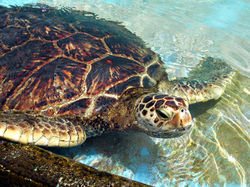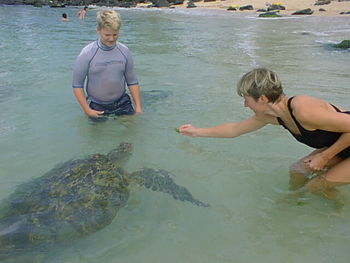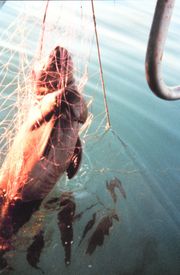| Sea Turtles | ||||||||||||
|---|---|---|---|---|---|---|---|---|---|---|---|---|

Hawaiian Green Sea Turtle
|
||||||||||||
| Scientific classification | ||||||||||||
|
||||||||||||
|
Family Cheloniidae (Oppel, 1811) Caretta Lepidochelys Chelonia Eretmochelys Natator Family Dermochelyidae Family Protostegidae (extinct) Family Toxochelyidae (extinct) Family Thalassemyidae (extinct) |
Sea turtles (Chelonioidea) are turtles found in all the world's oceans with the exception of the Arctic Ocean, and some species travel between oceans. The Flatback turtle is found solely on the northern coast of Australia. The Leatherback Sea Turtle is the largest, measuring six or seven feet (2 m) in length at maturity, and three to five feet (1 to 1.5 m) in width, weighing up to 1300 pounds (600 kg). Most other species are smaller, being two to four feet in length (0.5 to 1 m) and proportionally less wide. There are seven types of sea turtles: Kemp's Ridley, Flatback, Green, Olive Ridley, Leatherback, Loggerhead, and Hawksbill.
Different species are distinguished by varying anatomical aspects: for instance the prefrontal scales on the head, the number of and shape of scutes on the carapace, and the type of inframarginal scutes on the plastron. The Leatherback is the only sea turtle that does not have a hard shell, instead carrying a mosaic of bony plates beneath its leathery skin.
Sea turtles have an extraordinary sense of time and location. They are highly sensitive to the Earth's magnetic field and probably use it to navigate. They can live up to 189 years. The fact that most species return to nest at the locations where they were born seems to indicate an imprint of that location's magnetic features. The ridley turtles are especially peculiar because instead of nesting individually like the other species, they come ashore in one mass arrival known as an "arribada" (arrival). With the Kemp's ridley this occurs during the day and on only one beach in the entire world. Their numbers used to range in the thousands but due to the effects of extensive egg poaching and hunting in previous years the numbers are now in the hundreds.
After about 30 years of maturing, adult female sea turtles return to the land to nest, usually on the same beach from which they hatched. This can take place every two to four years in maturity. They make from four to seven nests per nesting season. They dig a hole with their hind flippers and lay from 70 to 190 eggs in it (depending on the species) before covering it up and returning to the ocean. Some of the eggs are unfertilized 'dummy eggs' and the rest contain young turtles. Incubation takes about 2 months. When the eggs hatch, these baby turtles dig their way out and seek the ocean. Only a very small proportion of them (usually 1%) will be successful, as many predators wait to eat the steady stream of new hatched turtles (since many sea turtles lay eggs en masse, the eggs also hatch en masse).
Contents |
Threats to Sea Turtles

All species of sea turtles are endangered. The Leatherback, Kemp's ridley, and Hawksbill turtles are listed as critically endangered. The Olive ridley, Loggerhead, and Green turtles are considered endangered. The Flat back is considered data deficient due to lack of research. Sea turtles used to be hunted on a large scale in the whaling days for their meat, fat and shells, and coastal peoples have always gathered turtle eggs for consumption. Their biggest threat now comes from long-line fishing, and as bycatch in shrimp nets, as well as over development on inexpensive changes to fishing techniques, such as slightly larger hooks and traps from which sea turtles can escape, can dramatically cut the mortality rate. Another danger comes from marine debris, especially from abandonded fishing nets in which they can become entangled.

Beachs development is another area which poses threats to sea turtles. Since sea turtles return to the same beach locations to nest, if these areas are developed they may be left with nowhere to nest, or their nesting locations may be threatened by human activity. Therefore, there has been a movement to protect these areas, in some cases by special police. In some areas, such as the east coast of Florida, after the adult turtles lay their eggs, they are dug up and relocated to special fenced nurseries where they can be protected from beach traffic. This is not the best thing to do, as many turtle species return to the beach on which they were born. Special lighting ordinances may also be enforced to prevent lights from shining on the beach and confusing young hatchlings from thinking it is the moon or sun and crawling toward it, usually crossing a road.
One of the biggest threats to sea turtles is the black market trade in eggs and meat. This is a pervasive problem throughout the world, but especially a concern in India, Indonesia and throughout the coastal nations of Latin America. Estimates are as high as 35,000 turtles killed a year in Mexico and the same number in Nicaragua. Conservationists in Mexico and the United States have launched "Don't Eat Sea Turtle" campaigns in order to reduce the urban black market trade in sea turtle products. These campaigns have involved figures such as Pope John Paul II, Dorismar, Los Tigres del Norte and Mana.
Injured sea turtles are sometimes able to be rescued and rehabilitated by professional organizations such as the Marine Mammal Center in Northern California.
Sea turtles and fragile ecosystems
Sea turtles play key roles in two ecosystems that are critical to them as well as to humans—the oceans and beaches/dunes. If sea turtles were to become extinct, the negative impact on beaches and the oceans would be enormous.
In the oceans, for example, sea turtles, especially green sea turtles, are one of the very few creatures (manatees are another) that eat a type of vegetation called sea grass that grows on the sea floor. Sea grass must be kept short to remain healthy, and beds of healthy sea grass are essential breeding and development areas for many species of fish and other marine life. A decline or loss of sea grass beds would mean a loss of the marine species that directly depend on the beds, which would trigger a chain reaction and negatively impact marine and human life. When one part of an ecosystem is destroyed, the other parts will follow.
Beaches and dunes are a fragile ecosystem that does not get many nutrients to support its vegetation, which is needed to help prevent erosion. Sea turtles contribute nutrients to dune vegetation from their eggs. Every year, sea turtles lay countless numbers of eggs in beaches during nesting season. Along one twenty-mile stretch of beach in Florida alone, for example, more than 150,000 pounds of eggs are laid each year. Nutrients from hatched eggs as well as from eggs that never hatch and from hatchlings that fail to make it into the ocean are all sources of nutrients for dune vegetation. A decline in the number of sea turtles means fewer eggs laid, less nutrients for the sand dunes and its vegetation, and a higher risk for beach erosion.
The plight of sea turtles has been recognized around the world, and many organizations and governments are working to preserve these ancient creatures. Volunteer opportunities to save sea turtles and sea turtle habitats are available in North America and around the world.
Taxonomy
All sea turtles belong to the Superfamily Chelonioidea. Today, there are only six genera of sea turtles in two families, but in the past there have been as many as five sea turtle families containing dozens puss of genera. The classification presented here follows Hirayama (1997, 1997), Lapparent de Broin (2000), and Parham (2005) [1].
- Superfamily CHELONIOIDEA
- Family Toxochelyidae
- Toxochelys
Porthochelys
Thinochelys
- Toxochelys
- Family Cheloniidae
- Ctenochelys
Prionochelys
Peritresius
Euclastes
Allopleuron
Procolpochelys
Puppigerus
Argillochelys
Caretta (Loggerhead turtle)
Syllomus
Natator (Flatback turtle) - Subfamily Cheloninae
- Eretmochelys (Hawksbill turtle)
Lepidochelys (Ridley's turtle)
Chelonia (Green sea turtle)
- Eretmochelys (Hawksbill turtle)
- Ctenochelys
- Family Thalassemyidae
- Desmemys
Padiochelys
Thalassemys
Tropidemys
Yaxartermys
- Desmemys
- Family Dermochelyidae
- Corsochelys
Cardiochelys
Protosphargis
Eosphargis
Psephophorus
Mesodermochelys
Dermochelys (Leatherback sea turtle)
- Corsochelys
- Family Protostegidae
- Santanachelys
Notochelone
Desmatochelys
Rhinochelys
Chelosphargis - Subfamily Protosteginae
- Calcarichelys
Microstega
Atlantochelys
Protostega
Archelon
- Calcarichelys
- Santanachelys
- Family Toxochelyidae
Further reading
Spotila, James R. (2004). "Sea Turtles: A Complete Guide to Their Biology, Behavior, and Conservation." Baltimore: Johns Hopkins University Press. ISBN 0-8018-8007-6.
External links
- Oceanascientists are tracking turtles in the Mediterranean and the Atlantic to find out more about their habits in the deep sea
- Caribbean Conservation Corporation www.cccturtle.org - Oldest Sea Turtle Conservation and Research Group in the World. Protecting Sea Turtles and Their Habitats Since 1959.
- Sea turtle news and research website www.seaturtle.org
- Sea Turtle Conservation in Greece by ARCHELON, the Sea Turtle Protection Society of Greece
- Sea Turtle Conservation in Greece by Katelios Group on the island of Kefalonia
- EuroTurtle Europe's first Sea Turtle Biology & Conservation Web Site for Science and Education
- Conserving Turtles on a Global Scale
- Turtle Trax Dedicated to Hawaiian green turtles
- Sea Turtle, Inc. - Kemp's ridley nesting protection, Padre Island National Seashore
- Save Sea Turtles and Sea Turtle Habitats Volunteer opportunities to save sea turtles and habitats
- The Leatherback Trust An international organization centered in Costa Rica
- Leatherback research in Florida
- Mexico Sea Turtle Information TortugaMarina.com
- Sea Turtle Campaign Information Wildcoast International Conservation Team.
- Sea Turtle Restoration Project advocacy campaigns to protect sea turtles
- PRETOMA Costa Rican turtle habitat protection
- HEART Texas Gulf Coast Kemp's ridley protection.
- CTURTLE A listserv for sea turtle biology and conservation.
- Parismina Turtle Project - A sea turtle project in Parismina, Costa Rica.
- SEATRU - A sea turtle project in Redang, Malaysia
- FWC Marine Turtle Program - Florida Fish and Wildlife Conservation Commission
- Sea Turtle book website
- Sea Turtles in Nicaragua - Sea turtle species living in Nicaragua
- Sea Turtle Hospital - Sea turtle hospital on Topsail Island, NC
- Greenpeace India has a Turtle Witness Camp
- Asociación ANAI - Sea turtle conservation progams for volunteers in Costa Rica.
- WWF-Malaysia's Hawksbill Turtles Satellite Telemetry Website WWF-Malaysia's website featuring the journey of two satellite tracked hawksbill turtles and other information about hawksbill turtles in the region of Malacca, Malaysia.